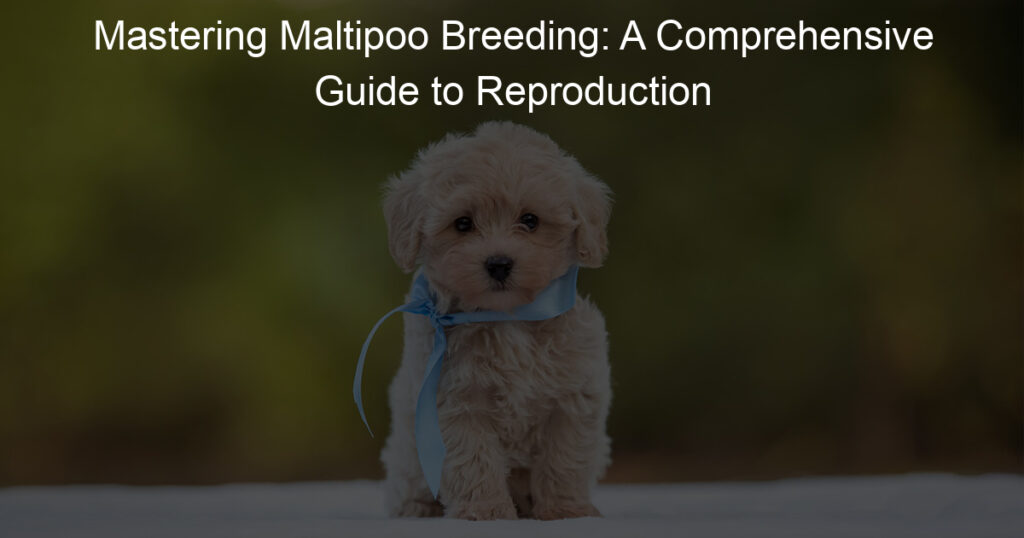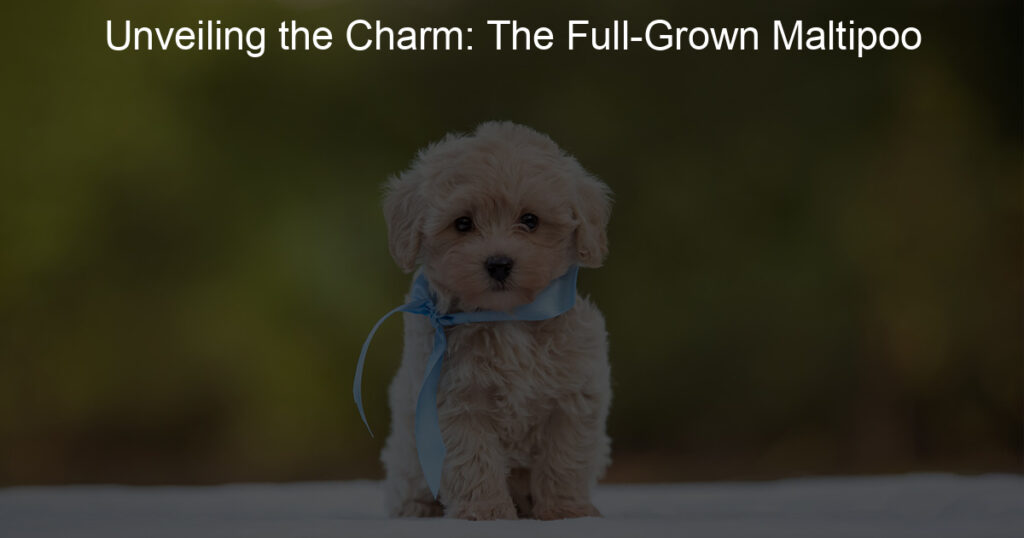
Introduction to Maltipoo Breeding
Delving into the world of Maltipoo breeding can be an exciting journey. These adorable, intelligent, and friendly dogs are a crossbreed between a Maltese and a Poodle, inheriting the best traits from both parents. However, breeding Maltipoos requires a comprehensive understanding of their reproduction process and a deep knowledge of their unique needs. In this guide, we will provide you with the essential information you need to start your Maltipoo breeding journey.
-
Understanding the Basics of Maltipoo Reproduction
Before you start breeding Maltipoos, it’s crucial to understand their reproductive process. Maltipoos, like all dogs, have a specific reproductive cycle. Female Maltipoos, known as bitches, typically have their first heat cycle between six and nine months of age. This cycle repeats approximately every six months. During this time, the female is receptive to mating with a male, known as a stud.
Successful mating results in pregnancy, which lasts around 63 days. A female Maltipoo can give birth to a litter of 2-5 puppies. Understanding these basics is the first step towards successful Maltipoo breeding.
-
Importance of Comprehensive Maltipoo Breeding Knowledge
Comprehensive knowledge of Maltipoo breeding isn’t just about knowing the mechanics of reproduction. It’s about understanding the genetic traits of the parent breeds, the potential health issues, and the best practices for ensuring the health and well-being of both the mother and the puppies.
For example, both Maltese and Poodles are prone to certain genetic health conditions. As a responsible breeder, it’s your job to ensure that the parent dogs are healthy and free of these conditions before breeding. This helps to ensure the health of the puppies and the long-term sustainability of the breed.
Furthermore, comprehensive knowledge also involves understanding the best practices for caring for the pregnant female and the newborn puppies. This includes providing proper nutrition, ensuring a safe and comfortable birthing environment, and knowing how to handle any potential complications that may arise during birth.
In the following sections, we will delve deeper into the ins and outs of Maltipoo breeding, including specific breeding techniques, pregnancy and birth guidance, and tips for best practices. Stay tuned to become a master in Maltipoo breeding.
Understanding Maltipoo Reproduction
In this section, we will delve into the fascinating world of Maltipoo reproduction. We will explore the Maltipoo breeding cycle, its stages, and the signs that indicate a Maltipoo is in heat. This knowledge is crucial for anyone interested in Maltipoo breeding.
Maltipoo Breeding Cycle
The Maltipoo breeding cycle is an essential aspect of Maltipoo reproduction. It consists of several stages, each with its unique characteristics and signs. Let’s explore these stages and signs in detail.
- Stages of the Maltipoo Breeding Cycle
- Signs of a Maltipoo in heat
- Increased urination: This is a way for the female Maltipoo to spread her scent and attract males.
- Swelling of the vulva: This is a physical sign that the Maltipoo is in heat.
- Behavioral changes: The Maltipoo may become more affectionate or agitated.
- Bleeding: This is a clear sign that the Maltipoo is in the Proestrus stage of her heat cycle.
The Maltipoo breeding cycle consists of four stages: Proestrus, Estrus, Diestrus, and Anestrus.
| Stage | Description |
|---|---|
| Proestrus | This is the beginning of the heat cycle. It lasts about 9 days, and during this time, the female Maltipoo will attract males but will not be ready to mate. |
| Estrus | This is the mating stage, which lasts about 9 days. The female Maltipoo is ready to mate during this stage. |
| Diestrus | This stage lasts about 60 days. If the Maltipoo has been successfully bred, this is the stage where pregnancy occurs. |
| Anestrus | This is the resting stage, which lasts about 130-150 days. The Maltipoo is not in heat during this stage and will not mate. |
Recognizing when a Maltipoo is in heat is crucial for successful breeding. Here are some signs to look out for:
Understanding the Maltipoo breeding cycle and recognizing the signs of a Maltipoo in heat are crucial steps in successful Maltipoo breeding. In the next section, we will explore the anatomy of Maltipoo reproduction.
Maltipoo Reproduction Anatomy
Understanding the reproductive anatomy of Maltipoos is crucial for successful breeding. Both male and female Maltipoos have unique systems that work together to create new life. Let’s explore these systems in more detail.
-
Male Maltipoo Reproductive System
The male Maltipoo’s reproductive system is quite simple. It consists of two main parts: the testes and the penis. The testes are responsible for producing sperm, which is necessary for fertilization. They also produce testosterone, a hormone that influences the dog’s behavior and physical appearance.
The penis, on the other hand, is used for mating. During mating, the sperm travels from the testes, through the penis, and into the female’s body. This process is known as ejaculation. It’s important to note that male Maltipoos reach sexual maturity around 6 to 12 months of age, but it’s recommended to wait until they are at least one year old before breeding.
-
Female Maltipoo Reproductive System
The female Maltipoo’s reproductive system is a bit more complex. It includes the ovaries, uterus, and vagina. The ovaries produce eggs and hormones such as estrogen and progesterone. When a female Maltipoo is in heat, one of the eggs is released from the ovaries in a process called ovulation.
The uterus is where the fertilized egg will develop into a puppy. If the egg isn’t fertilized, the lining of the uterus is shed during the dog’s heat cycle. The vagina serves as the birth canal during the delivery of puppies. Female Maltipoos typically reach sexual maturity at 6 to 9 months of age, but it’s advisable to wait until they are at least one year old before breeding to ensure they are physically mature enough to carry a pregnancy.
Understanding these systems is the first step towards successful Maltipoo breeding. Remember, responsible breeding practices are essential for the health and well-being of both the parent dogs and the puppies.
Maltipoo Breeding Ins and Outs
Understanding the ins and outs of Maltipoo breeding is crucial for anyone considering this endeavor. This section will provide valuable insights into choosing the right Maltipoos for breeding, including genetic considerations and health checks.
Choosing the Right Maltipoos for Breeding
Choosing the right Maltipoos for breeding is a process that requires careful consideration. It’s not just about picking the cutest dogs; it’s about ensuring the health and longevity of the breed. Let’s delve into the key factors to consider.
- Genetic considerations in Maltipoo Breeding
- Health checks for breeding Maltipoos
Genetics play a significant role in Maltipoo breeding. It’s essential to understand the genetic history of both parent dogs to predict the traits and health of the offspring. For instance, if both parents have a history of hip dysplasia, a common issue in small dogs, their puppies are likely to inherit this condition. Therefore, choosing Maltipoos with a healthy genetic history is paramount.
Before breeding, both Maltipoos should undergo thorough health checks. This includes general physical exams, blood tests, and screenings for common breed-specific conditions. Regular vet visits can help identify any potential health issues early, ensuring the healthiest possible puppies. Remember, a healthy parent equals a healthy puppy.
In conclusion, choosing the right Maltipoos for breeding involves careful consideration of genetics and health. By taking these factors into account, you can ensure the health and happiness of your Maltipoo puppies.
Mating Process
The mating process of Maltipoos, like any other breed, requires careful planning and understanding. Let’s delve into the best practices for successful Maltipoo mating and discuss common challenges that may arise during the process, along with effective solutions to overcome them.
- Best practices for successful Maltipoo mating
- Common challenges in Maltipoo mating and how to overcome them
Successful Maltipoo mating is not just about bringing two dogs together. It involves a series of steps that ensure the health and safety of both the dogs and their potential puppies.
Firstly, it’s important to ensure that both the male and female Maltipoos are healthy and have undergone necessary health checks. This includes genetic screening to avoid passing on any hereditary diseases to the puppies.
Secondly, understanding the female Maltipoo’s heat cycle is crucial. Typically, a female Maltipoo will go into heat twice a year. The best time for mating is during the second week of her heat cycle, when she is most fertile.
Lastly, provide a calm and comfortable environment for the dogs during the mating process. This helps reduce stress and increases the chances of successful mating.
Despite best practices, breeders may encounter challenges during the Maltipoo mating process. Let’s discuss some of these challenges and how to overcome them.
One common challenge is the refusal of the dogs to mate. This can be due to a variety of reasons such as stress, health issues, or lack of attraction. To overcome this, ensure both dogs are healthy and comfortable. If the problem persists, consider seeking advice from a professional breeder or a vet.
Another challenge is unsuccessful pregnancies. This can be due to health issues, age, or genetic factors. Regular health checks and genetic screening can help identify and address these issues early on.
Remember, patience and understanding are key in the Maltipoo mating process. It’s important to provide the best care for your dogs and seek professional advice when needed.
Maltipoo Breeding Techniques
In this section, we will delve into the various techniques used in Maltipoo breeding, focusing primarily on natural breeding. We will discuss the pros and cons of this method and provide tips on how to facilitate it.
Natural Breeding
Natural breeding refers to the process where Maltipoos mate and reproduce without human intervention. This method is often preferred by breeders who wish to maintain the natural instincts and behaviors of the breed.
- Pros and Cons of Natural Maltipoo Breeding
- How to Facilitate Natural Breeding in Maltipoos
- Monitor the female’s heat cycle: The female Maltipoo typically goes into heat twice a year. This is the best time for breeding.
- Ensure both dogs are healthy: Regular vet check-ups are crucial to ensure both dogs are in good health and free from any genetic disorders that could be passed onto the puppies.
- Provide a comfortable environment: The dogs should be comfortable and stress-free during the breeding process. This could mean providing a quiet, familiar environment for them to mate.
- Supervise the mating process: While it’s important to allow the dogs to mate naturally, supervision is necessary to prevent any potential injuries or aggressive behavior.
Natural breeding has its advantages and disadvantages. Let’s take a closer look at each.
| Pros | Cons |
|---|---|
| 1. It allows Maltipoos to exhibit their natural mating behaviors. | 1. It may lead to unplanned pregnancies if not monitored closely. |
| 2. It does not require any special equipment or procedures. | 2. There can be risks of injury or disease transmission between dogs. |
| 3. It can result in healthier puppies due to natural selection. | 3. It can be time-consuming as it relies on the dogs’ natural mating cycle. |
Facilitating natural breeding in Maltipoos requires careful planning and monitoring. Here are some steps to follow:
Artificial Insemination
Artificial insemination is another method used in Maltipoo breeding. This technique involves the manual placement of semen into the female Maltipoo’s reproductive tract. It is a scientific process that requires a good understanding of the Maltipoo’s reproductive cycle and professional assistance.
- Understanding the process of artificial insemination in Maltipoos
- When to consider artificial insemination for Maltipoo breeding
Artificial insemination begins with the collection of semen from a healthy male Maltipoo. This sample is then carefully introduced into the female Maltipoo’s reproductive tract at the optimal time in her cycle. The aim is to increase the chances of successful fertilization and pregnancy.
It’s important to note that this process should be carried out by a trained professional. They will ensure that the procedure is done correctly and safely, minimizing the risk of injury to both the male and female Maltipoo.
Artificial insemination is often considered when natural breeding is not successful or possible. It can be a good option for Maltipoos who have difficulty mating naturally due to physical limitations or health issues.
Additionally, artificial insemination can be a useful tool for breeders who want to maintain genetic diversity in their Maltipoo population. It allows for the use of semen from males that are not physically present, opening up a wider range of potential breeding partners.
In conclusion, artificial insemination is a valuable tool in Maltipoo breeding. It can help overcome challenges associated with natural breeding and increase the genetic diversity of the Maltipoo population. However, it is a complex process that should be undertaken with the guidance of a professional.
Guide to Breeding Maltipoos: Pregnancy and Birth
One of the most crucial stages in the breeding process of Maltipoos is the pregnancy and birth phase. Understanding this phase can help ensure the health and well-being of both the mother and her puppies.
Pregnancy in Maltipoos
Pregnancy in Maltipoos is a delicate period that requires careful attention. It is important to know the signs of pregnancy and how to care for a pregnant Maltipoo.
- Signs of pregnancy in Maltipoos
- Caring for a pregnant Maltipoo
Recognizing the signs of pregnancy in Maltipoos is the first step. Some of the signs include increased appetite, weight gain, and changes in behavior such as increased affection or lethargy. The dog’s abdomen will also start to swell around the fourth week of pregnancy.
Caring for a pregnant Maltipoo involves providing a balanced diet, regular exercise, and regular vet check-ups. It’s also important to provide a comfortable and safe space for the dog to rest. Avoid any stressful situations as it can affect the dog’s health and the health of the puppies.
Understanding the pregnancy process in Maltipoos is essential for successful breeding. It ensures the health and safety of the mother and her puppies, and it can also help prevent any potential complications during birth.
| Signs of Pregnancy | Care Tips |
|---|---|
| Increased appetite, weight gain, changes in behavior, swelling of the abdomen | Provide a balanced diet, regular exercise, regular vet check-ups, comfortable and safe resting space, avoid stressful situations |
As a breeder, it’s your responsibility to ensure the well-being of the Maltipoo during her pregnancy. This not only ensures a healthy litter of puppies but also maintains the health of the mother.
Birth and Newborn Care
Bringing new Maltipoo puppies into the world is an exciting and rewarding experience. However, it’s important to understand the birthing process and how to care for newborn puppies to ensure their health and well-being.
- Understanding the birthing process in Maltipoos
- How to care for newborn Maltipoo puppies
The birthing process, also known as whelping, begins with the Maltipoo mother showing signs of nesting and restlessness. This is followed by the water breaking and contractions. Each puppy is delivered in its own amniotic sac, which the mother will usually break and clean. It’s crucial to monitor this process closely and be ready to intervene if necessary, for example, if a puppy is stuck or the mother is not removing the sac.
Newborn Maltipoo puppies require a warm, safe environment and plenty of nutrition. They should start nursing from their mother immediately after birth. It’s important to monitor their weight gain daily to ensure they are growing properly. Puppies should also be checked regularly for signs of illness, such as lethargy, refusal to nurse, or constant crying. At around two weeks old, their eyes will open, and they will start to explore their surroundings.
Remember, caring for newborn puppies is a big responsibility. They are completely dependent on their caregiver for the first few weeks of their life. With the right knowledge and preparation, you can ensure your Maltipoo puppies grow into healthy, happy adults.
| Stage | Key Care Points |
|---|---|
| Birth | Monitor the birthing process, be ready to intervene if necessary |
| First 24 hours | Ensure puppies start nursing immediately, keep them warm and safe |
| First week | Monitor weight gain daily, check for signs of illness |
| Two weeks | Watch as puppies start to explore, continue monitoring health and growth |
Maltipoo Reproduction Tips and Best Practices
When it comes to Maltipoo reproduction, there are several factors to consider. One of the most important aspects is health and nutrition. Let’s delve into why this is so crucial and what diet is recommended for breeding Maltipoos.
Health and Nutrition
Health and nutrition play a pivotal role in Maltipoo reproduction. A healthy diet not only ensures the overall well-being of your Maltipoo but also enhances their reproductive capabilities.
- Importance of nutrition in Maltipoo reproduction
- Recommended diet for breeding Maltipoos
Proper nutrition is vital for a Maltipoo’s reproductive health. A balanced diet helps maintain a healthy weight, which is crucial for successful breeding. Overweight or underweight Maltipoos may face difficulties during breeding. Moreover, certain nutrients are essential for the development of healthy puppies. For instance, Folic Acid is necessary for the development of the neural tube, while Calcium and Phosphorus are needed for bone development.
When it comes to the diet of a breeding Maltipoo, it is recommended to feed them high-quality commercial dog food that is specifically designed for small breeds. These foods typically contain the right balance of nutrients needed for reproduction. Additionally, you may supplement their diet with fresh fruits, vegetables, and lean meats. However, it’s important to consult with a vet before making any significant changes to your Maltipoo’s diet.
In conclusion, maintaining proper health and nutrition is key to successful Maltipoo reproduction. By providing your Maltipoo with a balanced diet, you can ensure their well-being and enhance their reproductive capabilities.
Regular Vet Check-ups
- Why regular vet check-ups are crucial for breeding Maltipoos
- What to expect during a Maltipoo breeding vet check-up
Regular vet check-ups play a vital role in the successful breeding of Maltipoos. These adorable, fluffy companions require careful monitoring to ensure their health and wellbeing. Vet check-ups provide an opportunity to assess the overall health of the Maltipoo, identify any potential health issues, and administer necessary vaccinations. This is particularly important for breeding Maltipoos, as any health issues could potentially be passed on to their puppies.
Moreover, regular vet visits are crucial for monitoring the Maltipoo’s reproductive health. Vets can provide valuable advice on the best time for breeding, ensuring the highest chance of successful conception. They can also provide guidance on the care of pregnant Maltipoos, helping to ensure a smooth pregnancy and birth.
During a Maltipoo breeding vet check-up, the vet will conduct a thorough physical examination of the Maltipoo. This includes checking the Maltipoo’s weight, temperature, heart rate, and respiratory rate. The vet will also examine the Maltipoo’s coat, eyes, ears, teeth, and gums for any signs of illness or disease.
In addition to the physical examination, the vet may also conduct blood tests to check for any underlying health issues. These tests can provide valuable information about the Maltipoo’s overall health and reproductive fitness.
Furthermore, the vet will discuss the Maltipoo’s diet and exercise routine, as these factors can significantly impact the Maltipoo’s reproductive health. The vet may provide recommendations for dietary adjustments or exercise routines to optimize the Maltipoo’s health for breeding.
Conclusion: Mastering Maltipoo Breeding
As we reach the end of our comprehensive guide on Maltipoo breeding, it’s time to summarize the key points and look ahead to the future. Breeding Maltipoos is a rewarding and fulfilling endeavor, but it requires knowledge, dedication, and a genuine love for these adorable creatures. Let’s recap the essential takeaways and explore the resources available for continuing education in Maltipoo breeding.
- Key takeaways from the Maltipoo Breeding Guide
- Maltipoos, a crossbreed of Maltese and Poodles, are known for their intelligence, affectionate nature, and hypoallergenic coats.
- Understanding the reproductive cycle of Maltipoos is crucial for successful breeding. Females typically go into heat twice a year, and the optimal breeding time is during the second week of the heat cycle.
- Proper care and nutrition of the pregnant Maltipoo are vital for the health of the mother and puppies. Regular vet check-ups are essential.
- Breeding Maltipoos requires a commitment to the well-being of the dogs, including proper socialization and training of the puppies before they go to their new homes.
- Continuing education and resources for Maltipoo breeders
- Books on dog breeding: These provide valuable insights into the science and art of breeding. Some recommended titles include “The Dog Breeder’s Guide to Successful Breeding and Health Management” by Margaret V. Root Kustritz and “The Art of Raising a Puppy” by the Monks of New Skete.
- Online forums and communities: These platforms allow breeders to share experiences, ask questions, and learn from each other. Examples include the Maltipoo Club on Facebook and the Maltipoo subreddit on Reddit.
- Continuing education courses: Some institutions offer courses on dog breeding and genetics. These can provide a deeper understanding of the science behind breeding.
Our guide has covered a wide range of topics, from understanding Maltipoo reproduction to mastering the ins and outs of the breeding process. Here are the most critical points to remember:
Mastering Maltipoo breeding is a continuous learning journey. Here are some resources to help you stay updated and enhance your breeding skills:
In conclusion, Maltipoo breeding is a complex yet rewarding task. It requires a deep understanding of the breed, a commitment to the well-being of the dogs, and a willingness to continuously learn and improve. With the right knowledge and resources, you can master the art of Maltipoo breeding and contribute to the health and happiness of this adorable breed.








